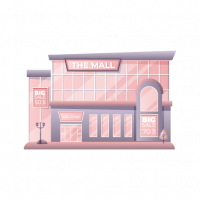Proximity Marketing | Engaging Intent Driven Shoppers | Digitally

In the age of hyper-personalized experiences, proximity marketing has emerged as a powerful tool for brick-and-mortar retailers — especially those operating in shopping malls. With the ability to connect with shoppers in real time, proximity marketing allows brands to engage with consumers when they're most likely to make a purchase. But what makes this strategy particularly effective? The answer lies in tapping into intent-driven audiences.
What is Proximity Marketing?
Proximity marketing refers to the use of location-based
technology to communicate with potential customers who are physically near a
business. By leveraging tools such as Bluetooth beacons, Wi-Fi signals,
geofencing, and near-field communication (NFC), brands can send targeted
messages, promotions, or notifications directly to shoppers' smartphones.
In the context of malls, proximity marketing becomes even
more relevant. With high foot traffic and a diverse mix of retailers, malls
offer a goldmine of opportunities for personalized, real-time engagement.
Understanding the Intent-Driven Shopper
One of the most valuable aspects of proximity marketing is
its ability to reach intent-driven audiences. These are consumers who
are not just browsing online but are physically present in a retail environment
— indicating a much stronger intent to buy.
For example, a shopper walking through a mall on a Saturday
afternoon is likely looking for something specific: a new outfit, a gift, or
maybe a bite to eat. This situational context provides a perfect moment for
targeted messaging. By tapping into this intent, retailers can influence
decision-making right before the point of purchase.
How Proximity Marketing Works in Malls
Let’s break down how a typical proximity marketing strategy
can unfold in a mall setting:
1. Bluetooth Beacons and Geofencing
Retailers install Bluetooth beacons or define geofenced
areas within the mall. When a customer with the mall’s app (or a participating
retailer's app) enters the area, they can receive push notifications.
2. Personalized Offers
Based on past shopping behavior, app preferences, or time of
day, shoppers might receive personalized discounts — for example, “20% off your
favorite coffee if you buy in the next 30 minutes.”
3. Real-Time Engagement
Interactive campaigns like scavenger hunts, flash sales, or
loyalty rewards can be triggered by physical proximity, making shopping more
engaging and memorable.
Benefits for Retailers and Mall Operators
- Increased
Foot Traffic: Personalized deals and notifications can direct shoppers
to specific stores they might have otherwise skipped.
- Higher
Conversion Rates: Messaging shoppers at the moment of intent increases
the likelihood of immediate purchases.
- Better
Customer Insights: Retailers can track movement patterns and
preferences, allowing for data-driven marketing decisions.
- Enhanced
Shopper Experience: When done right, proximity marketing feels like a
helpful nudge, not a hard sell.
Key Considerations for a Successful Strategy
While proximity marketing holds immense promise, success
depends on careful planning and execution:
- Opt-In
Policies: Ensure shoppers have clearly opted in to receive messages.
Transparency builds trust.
- Relevance
is Key: Irrelevant or spammy notifications can lead to app uninstalls.
Keep content valuable and timely.
- Data
Privacy Compliance: Stay updated with GDPR, CCPA, and other data
protection laws to ensure your strategy is compliant.
- App
Integration: Most proximity strategies rely on users having a specific
app. Incentivize downloads with exclusive deals or loyalty programs.
The Future of In-Mall Marketing
As technology evolves, so will proximity marketing
strategies. Integration with AI will enable even smarter targeting. Augmented
Reality (AR) may allow for immersive experiences triggered by physical
location. Voice assistants and wearables could further change how shoppers
interact with their environment.
The bottom line? Shopping malls that embrace proximity
marketing are not just selling products — they're delivering context-rich
experiences that align with consumer intent.
Final Thoughts
Proximity marketing in malls is no longer a futuristic
concept — it's a practical, powerful way to engage with ready-to-buy consumers.
By understanding the needs and behaviors of intent-driven audiences, retailers
can craft real-time, personalized experiences that drive foot traffic, boost
sales, and build long-term loyalty.
Elyts Advertising and Branding Solutions | www.elyts.in (India) | www.elyts.agency (UAE)






















Leave a Comment